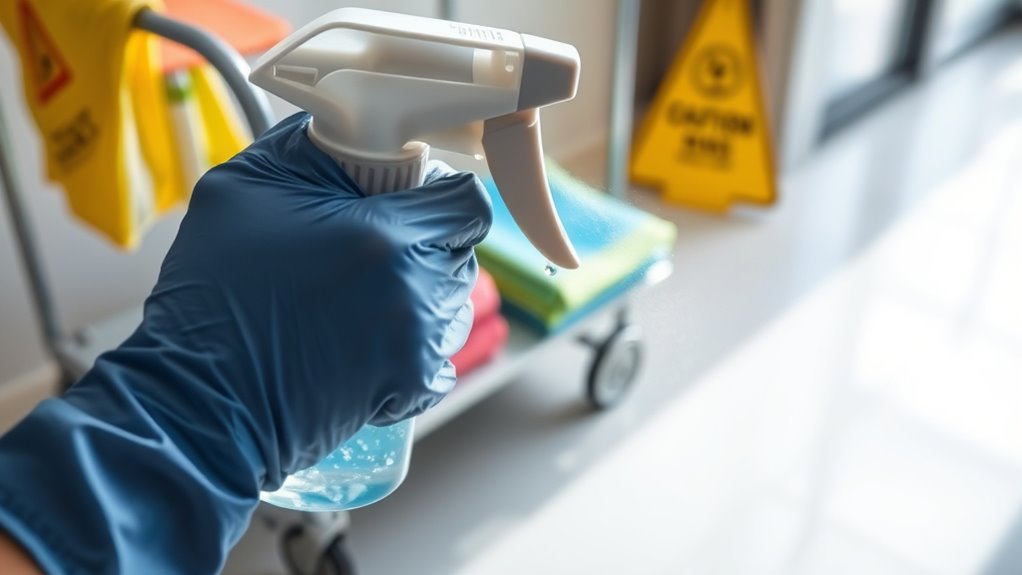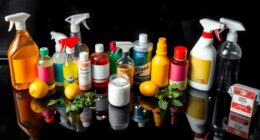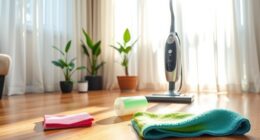To stay safe as a cleaning professional, always wear the right Personal Protective Equipment (PPE) like gloves, masks, and goggles. Handle and store cleaning chemicals safely—keep them upright and labeled. Watch out for slips, trips, and falls; use caution signs and maintain non-slip footwear policies. Regular training on safety protocols is essential. By prioritizing these practices, you’ll foster a safer work environment. There’s more to learn about enhancing your safety—keep going for valuable tips!
Key Takeaways
- Always wear appropriate Personal Protective Equipment (PPE), including gloves, masks, goggles, and non-slip footwear to protect against hazards.
- Store cleaning chemicals in original containers, clearly labeled, and away from food to prevent contamination.
- Regularly inspect work areas for potential slip, trip, and fall hazards, and utilize caution signs when needed.
- Participate in ongoing safety training and refresher courses to stay updated on safety protocols and best practices.
- Encourage open communication about unsafe conditions and report any hazards immediately to maintain a safe work environment.
Understanding the Importance of Cleaning Safety
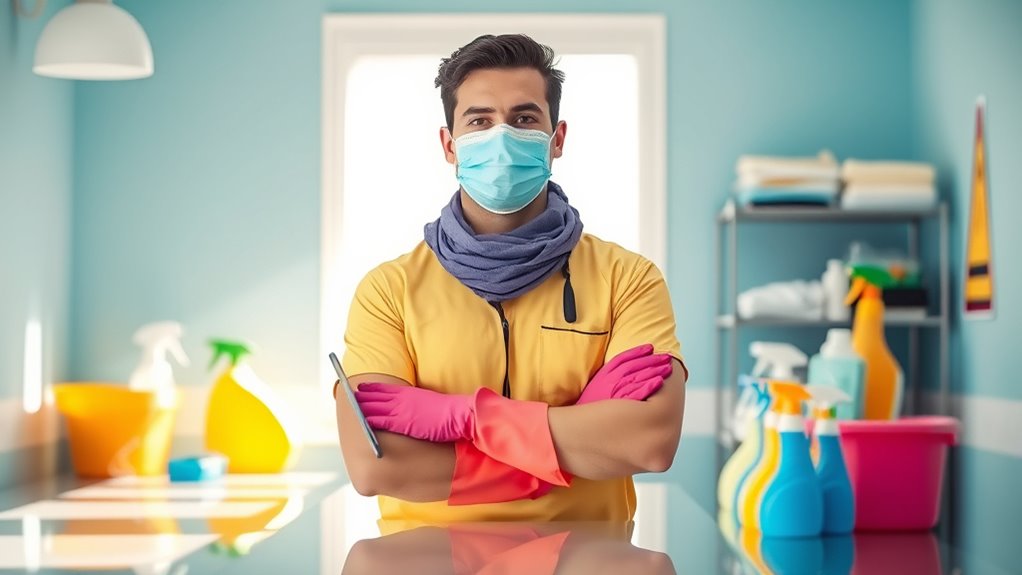
When you prioritize cleaning safety, you not only protect yourself from potential hazards but also contribute to a healthier work environment.
Understanding the importance of cleaning safety is fundamental for cleaning professionals. Effective safety protocols help you adhere to health and safety procedures, minimizing risks associated with hazardous chemicals and physical tasks.
Regular training guarantees that you and your colleagues use Personal Protective Equipment (PPE) properly, reducing exposure to harmful substances.
Compliance with safety regulations, like those from OSHA, is critical for maintaining workplace safety and can boost productivity and morale.
By fostering a culture of safety, you promote health and well-being, which is especially significant in high-risk sectors such as healthcare and hospitality.
Prioritize safety, and you’ll reap the benefits.
Essential Personal Protective Equipment for Cleaners
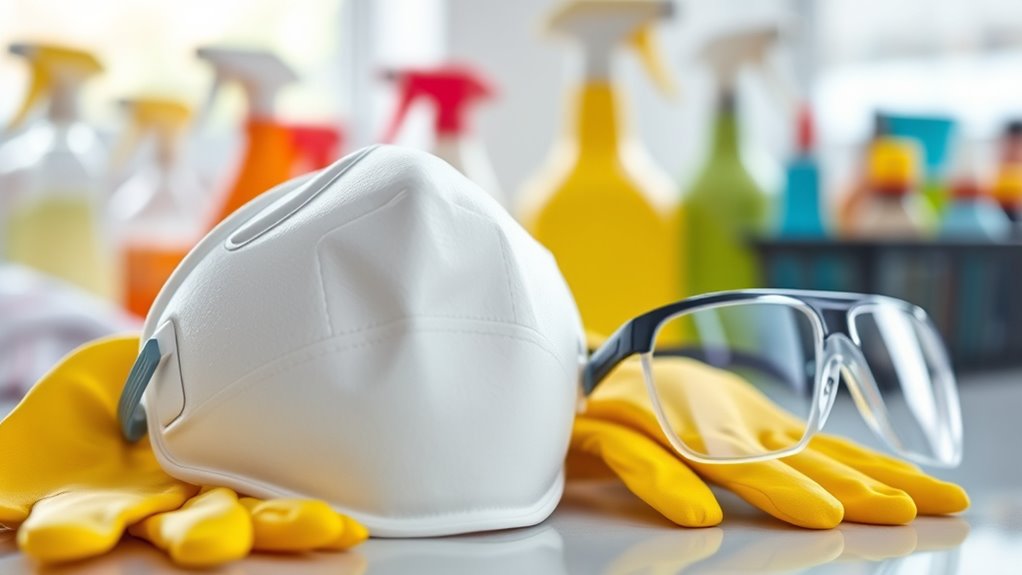
To guarantee your safety while cleaning, it’s vital to wear the right Personal Protective Equipment (PPE).
Start with gloves made from chemical-resistant materials to protect your hands from hazardous cleaning agents and pathogens. Masks or respirators are essential for preventing the inhalation of dust, fumes, and harmful chemicals, especially in poorly ventilated areas.
Don’t forget safety goggles; they shield your eyes from splashes and debris when using strong cleaning chemicals. Additionally, invest in non-slip footwear to minimize the risk of slips and falls in wet or hazardous environments.
Finally, establish a nightly checklist for compliance to verify all cleaning staff are properly equipped, fostering a consistent safety culture in your workplace.
Stay safe and protect yourself!
Safe Handling and Storage of Cleaning Chemicals
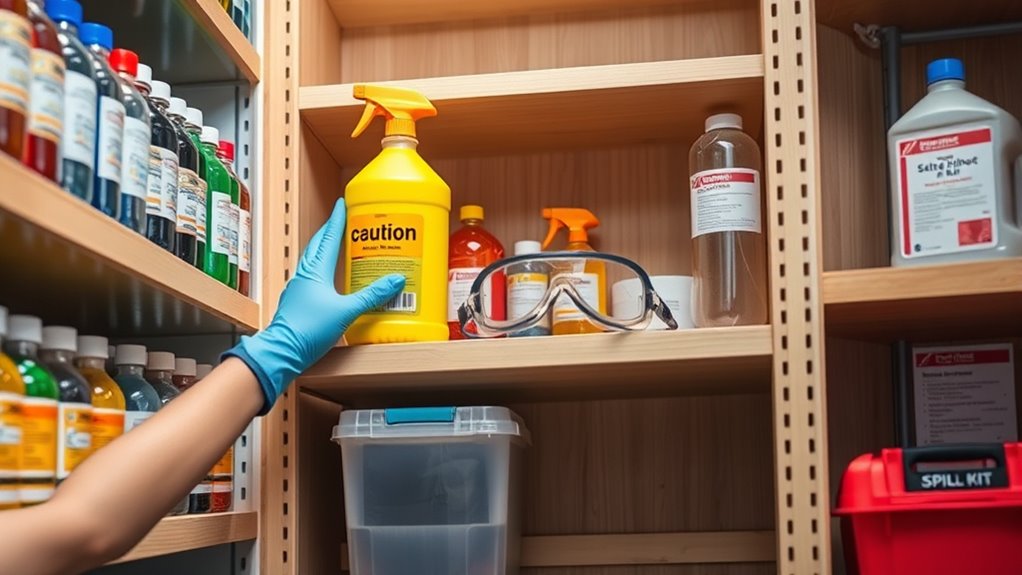
Wearing the right personal protective equipment is just the first step in guaranteeing your safety as a cleaning professional.
Always store cleaning chemicals upright in their original containers to prevent leaks and guarantee they’re clearly labeled. This helps avoid mix-ups and hazardous situations.
Regularly check your cleaning supplies for expiration dates and dispose of any unused chemicals according to local regulations. Keep your storage area separate from food and personal items to prevent contamination.
When mixing chemicals, read labels carefully, adding water first to avoid dangerous reactions.
Don’t forget to wear appropriate Personal Protective Equipment (PPE), like gloves and goggles, to protect yourself from potential hazards and guarantee safe handling of cleaning products.
Your safety depends on it!
Best Practices for Preventing Slips, Trips, and Falls
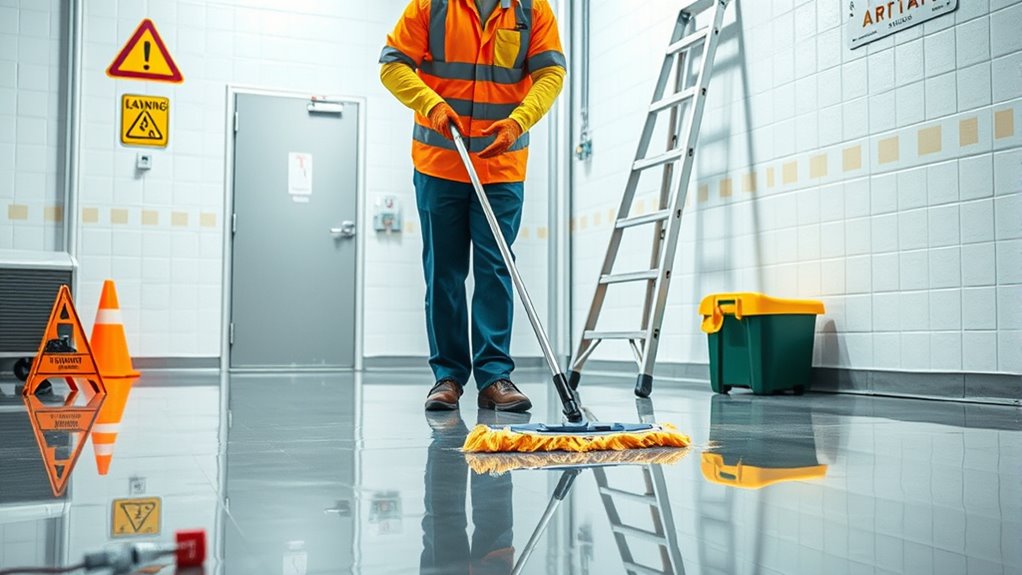
Although slips, trips, and falls are among the most common workplace injuries, you can take proactive steps to minimize these risks in your cleaning environment.
Start by shifting from wet mopping to vacuuming; this helps prevent wet floors that increase fall hazards. Regularly inspect stairways and enforce non-slip footwear policies to enhance safety.
Always utilize caution signs and barriers to alert others of cleaned or wet areas, especially in high-traffic zones. Encourage your team to report potential hazards and hold regular safety meetings to discuss best practices.
Implementing these cleaning safety tips fosters a culture of safety awareness, creating a safer working environment and greatly reducing the incidence of slips, trips, and falls.
Training and Communication for a Safer Work Environment
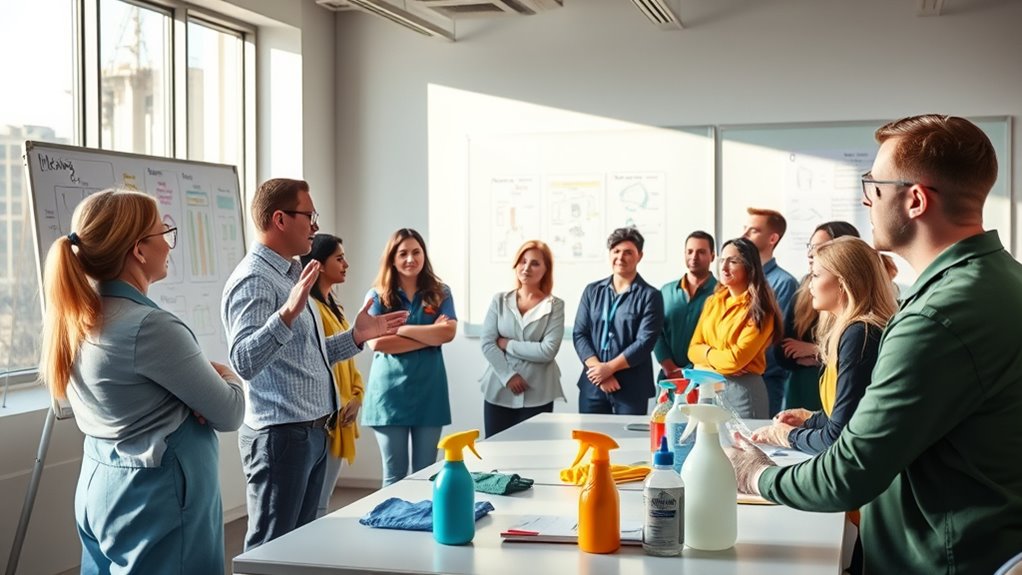
Effective training and open communication are essential for creating a safer work environment in the cleaning industry. Thorough training programs should cover chemical safety, proper equipment use, and emergency procedures.
Effective training and open communication are vital for ensuring safety in the cleaning industry.
Regular safety meetings enhance communication and allow employees to share experiences and insights about hazards.
- Implement a reporting system for unsafe conditions to encourage employees to voice concerns.
- Offer refresher courses to keep workers updated on safety practices and regulations.
- Foster effective communication channels, like weekly crew manager meetings, to discuss incidents and performance.
Frequently Asked Questions
What Are the Safety Precautions for Cleaners?
When you’re cleaning, it’s essential to take safety precautions.
Always wear the right Personal Protective Equipment (PPE) like gloves and masks to shield yourself from harmful substances.
Make sure the area is well-ventilated, especially when using strong chemicals.
Store your cleaning products properly, away from food.
Use safe lifting techniques to avoid injury, and regularly check your equipment for any damage.
Staying vigilant can help prevent accidents and keep you safe while working.
What Is the Golden Rule for Cleaning?
You’d think cleaning would be straightforward, right?
But the golden rule for cleaning is to always follow the manufacturer’s instructions for your cleaning products. Ignoring that can lead to ineffective results or even accidents.
It’s like trying to bake a cake without the recipe—chaos ensues!
So, embrace those guidelines, and you’ll achieve the best results while keeping everything safe and sound.
Trust me, it’ll save you a lot of headaches in the long run.
What Are the 6 Measures in Keeping a Workplace Clean and Safe?
To keep a workplace clean and safe, you should implement regular cleaning schedules, guaranteeing high-traffic areas are prioritized.
Store cleaning supplies in labeled containers away from food to prevent contamination.
Use ergonomic tools to reduce strain, and maintain proper ventilation to improve air quality.
Establish clear protocols for spill management, and guarantee everyone knows emergency procedures for hazardous materials.
These measures help create a healthier environment for everyone involved.
What Are the 5 Points of Cleaning?
Picture yourself as a cleaning superhero, cape fluttering as you tackle grime!
First, you prepare by clearing clutter and gathering your trusty supplies.
Next, you plunge into cleaning, banishing dirt with your favorite agents.
After that, you sanitize, zapping away germs to keep everyone safe.
Don’t forget drying—no one wants a slip-and-slide incident!
Finally, maintaining surfaces guarantees your efforts last, keeping your space fresh and sparkling for all.
You’ve got this!
Conclusion
In summary, prioritizing safety is vital for you as a cleaning professional. By wearing the right personal protective equipment and handling chemicals wisely, you can reduce risks considerably. Remember to stay vigilant against slips and trips, and engage in regular training to enhance communication within your team. Just as the ancient Romans valued safety for their legions, you too must embrace these practices to guarantee a secure and efficient work environment. Your well-being matters!

